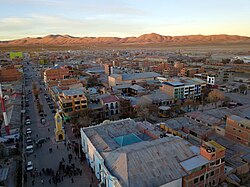Uyuni | |
|---|---|
City | |
 Plaza Arce adjoins Potosí Avenue to mark the center of town. | |
| Coordinates: 20°27′46″S66°49′26″W / 20.46278°S 66.82389°W | |
| Country | Bolivia |
| Department | Potosí Department |
| Province | Antonio Quijarro Province |
| Municipality | Uyuni Municipality |
| Canton | Uyuni Canton |
| Population (2012) | |
• Total | 29,672 [1] |
| • Ethnicities | Quechua Aymara |
| Time zone | UTC-4 (BOT) |
Uyuni (Aymara, uyu pen, yard, cemetery, [2] -ni a suffix to indicate ownership, "the one that has got a pen", "the one with a pen") is a city in the southwest of Bolivia.
Contents
Uyuni primarily serves as a gateway for tourists visiting the world's largest salt flats, the nearby Salar de Uyuni. Each year the city receives approximately 60,000[ citation needed ] visitors from around the globe. The city also acts as a gateway for commerce and traffic crossing into and out of Bolivia from and to Chile, and there is a customs and immigration post downtown. Agriculture in the area is generally limited to quinoa, llamas, and sheep. [3] [4]
Founded in 1890 as a trading post, the city has a population of 29,672 (2012 official census). [1] The town has an extensive street-market. It lies at the edge of an extensive plain at an elevation of 3,700 m (12,139 ft) above sea level, with more mountainous country to the east.











